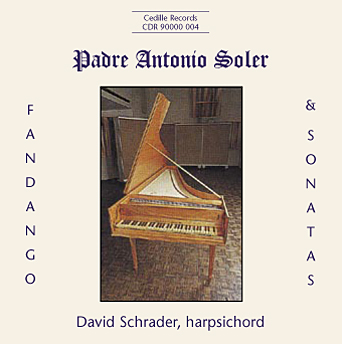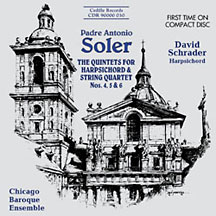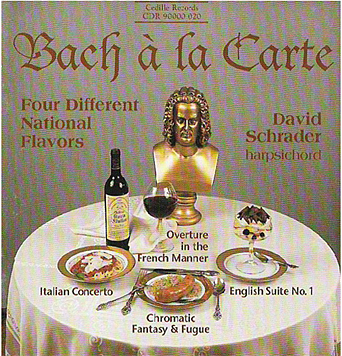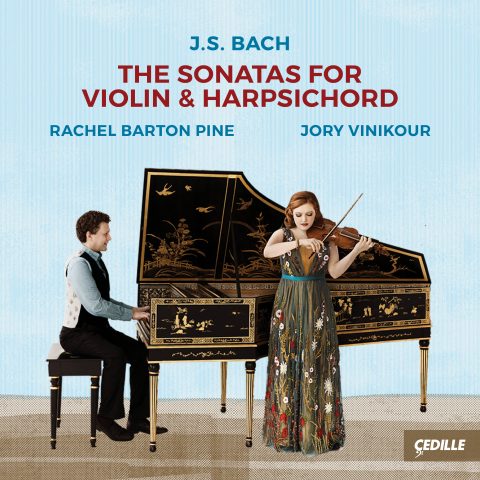Store
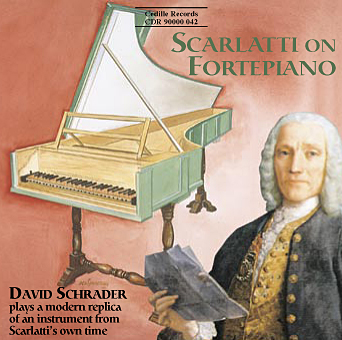
Scarlatti on Fortepiano sheds new light on Domenico Scarlatti’s keyboard sonatas and the early piano, or “fortepiano,” of the composer’s own time. The fortepiano, available to Scarlatti (1685-1757) in the royal palaces of Spain, was part of his sonic world. Yet the many Scarlatti sonata recordings on the market typically employ harpsichord or modern piano.
Paradoxically, most fortepiano recordings offer music of the Classical and early Romantic periods, many of whose composers were starting to outgrow the early piano’s capabilities, observes recording producer Jim Ginsburg. “On fortepiano, Scarlatti’s baroque sonatas present the performer with interpretive opportunities, rather than constraints,” he says.
Keyboard artist David Schrader, a virtuoso on both harpsichord and fortepiano, says he tried to select, from among Scarlatti’s 550 sonatas, those that benefit from the fortepiano’s unique sound and its ability to employ “dynamic variation for the purpose of phrasing.” Some of these sonatas (actually single-movement exercises) are quintessentially Spanish, while others show Scarlatti’s “Roman” Italian side.
“All these pieces blossom in new ways through the fortepiano’s expressive dynamics and tantalizing timbres,” Ginsburg says. “This is no carbon-copy Scarlatti.”
In an essay in the CD booklet, David Sutherland, builder of the fortepiano heard on the CD, outlines historical evidence that “Scarlatti knew and loved the piano . . . that he was, in short, the first of the great pianist-composers in the line that runs through Mozart and Beethoven and the great romantic lions to Bartok and Prokofiev in our own century.”
Highlights of the 79-minute CD include the sonata K. 52, with its four (and sometimes five) distinct voices — and a richness of harmony and counterpoint that’s almost Brahmsian. The fast-fingered virtuosity of K. 517 seems to anticipate the pearling sound of much later piano music. The Andalusian harmony and vigorous dance rhythms of Scarlatti’s Spanish-style K. 239 contrasts with the sweetness, purity, and innocent festivity of the Roman-syle K. 513. The witty and capricious K. 405, Schrader writes, “conjures up Beethoven in a very light (and slightly manic) vein, specifically the scherzo from Symphony No. 7.”
Schrader performs on Sutherland’s mint-condition modern replica of a 1726 instrument: the last surviving piano built by Bartolomeo Cristofori, the Italian instrument maker who invented the piano around 1700. The pleasing sound of this “new” fortepiano, built for the Schubert Club of St. Paul, Minnesota, demonstrates that “early piano sound need not be painful,” Cedille’s Ginsburg says.
Preview Excerpts
DOMENICO SCARLATTI (1685-1757)
Artists
Program Notes
Download Album BookletNotes on the Program
Notes by David Schrader
My conversations with David Sutherland, the builder of the instrument used on this recording, convinced me that Domenico Scarlatti was probably an enthusiastic player of the newly-invented piano. I became intrigued by the sound of Scarlatti’s music performed on pianos of his era — or reproductions of such instruments — an interest that ultimately led to this recording project: Scarlatti’s sonatas performed on a modern replica of an instrument on which Scarlatti may well have played. For this recording, I tried to choose sonatas that made good use of the early piano’s tonal and expressive capabilities, as opposed to those of the harpsichord. While the two instruments share certain qualities, I looked for works that benefitted from the different sound of the piano and its ability to employ dynamic variation for the purpose of phrasing. I also wanted to include sonatas that reflected Scarlatti’s roots in the Italian, especially Roman, tradition as well as his enthusiastic adoption of characteristically Spanish folk music.
Domenico Scarlatti was carefully groomed by his father, the famous Alessandro (1660-1725), for a major musical career. While Alessandro made his name chiefly from the success of his operas, it appeared that early on that Domenico had a particular gift for playing and composing for keyboard instruments. (As might be expected from a musician of his time, Scarlatti also composed in many other genres: for example, he composed six operas during the years 1709-1713, while in the employ of Maria Casimira, the exiled queen of Poland.) From 1705-09, Scarlatti lived in Venice. Almost nothing is known of his activities there, except for a famous playing contest with the young Saxon, Georg Friedrich Händel — Scarlatti’s exact contemporary — most likely in 1708. As with the celebrated musical duel between Franz Liszt and Sigismond Thalberg 125 years later, the event ended in a draw, with a decision in favor of Händel on the organ and Scarlatti on the harpsichord. In his essay, Mr. Sutherland explains Scarlatti’s circumstantial involvement with the early Florentine piano, and its probable frequent use alongside the harpsichord.
The piano’s capacity for dynamic accent makes it particularly apt for the lyricism and dissonances heard in the sonata in C major, K. 132, which opens the program. The brilliance and rhythmic drive of the sonata in C minor, K. 129, contrast nicely with K. 132. Roulades of menacing chromatic scales typify the great passion and intensity of the sonata in F minor, K. 386. The sun comes out again in the forthright, diatonic harmony of K. 44 in F major, with its insouciant melodies and jaunty octaves in the left hand. K. 43, in G minor, adds a touch of enigma to the program. The piano heightens the contrast of textures in K. 209, which makes imaginative and pointed use of two-voiced counterpoint punctuated by full chords. While there is little of the darkness of Andalusian music, these chords remind one of the strumming of a guitar. The elegance and restrained pathos of K. 434 is followed by the slightly impish mischief in the sonata in C Minor, K. 84. The rapid figures and repeated notes in this piece take on a distinct character on the Christofori/Sutherland instrument. K. 239 and K. 513 contrast strikingly — K. 239 is the most “Spanish” work heard on the disc thus far, with its insistent dance rhythms and impetuous spirit, while K. 513 incorporates the sense of innocent festivity heard in many Roman “Christmas” pieces of the early eighteenth century, complete with gentle pastoral undulations and the imaginary pealing of church bells. The mysterious and lyrical vein of K. 158 is followed by the bold virtuosity of K. 113, which, even for Scarlatti, contains an astonishing number of hand-crossings per page. No true Scarlatti program would be complete without such a piece! The exceptional K. 52 in D minor maintains four real voices throughout, sometimes augmented to five. The fullness of its harmony and counterpoint suits the piano well, giving a feeling of — dare I say it — Brahmsian richness. K. 519 is surely inspired by Spanish folk music. Castanets were not far from my imagination when making the recording — even on a December night in St. Paul, Minnesota! The piano’s sound in K. 405 conjures up Beethoven in a very light (and slightly manic) vein — specifically the scherzo from Symphony No.7. K. 308 moves gently and songfully in a way similar to K. 132, although with much less dissonance. The bold rhythmic attack possible on either the early piano or the harpsichord evokes the dance in the “Gavota,” K. 64. Lastly, the sound produced by the hammered action of the piano in the virtuosic sonata in D minor, K. 517 makes a perfect conclusion to the program.
The sound world of Domenico Scarlatti, and of his contemporaries who experienced the novelty of the “cembalo col piano e forte,” was greatly enriched and enlightened. We are fortunate to have such an instrument replicated, so that we may be transported to an era in which the harpsichord lived side by side with its new hammered cousin.
Scarlatti and the Piano
Notes by David Sutherland
Scarlatti sonatas performed on piano? Surely this is an insult to the spirit of AUTHENTICITY that now commands the realm of recorded classical music. Leave aside for the moment that some of this century’s greatest pianists regularly included Scarlatti in their programs — Myra Hess for one, Vladimir Horowitz for another. Let us get right to the heart of the matter by stating that the evidence — such as it is — suggests that Domenico Scarlatti knew and loved the piano, that he sparked general interest in the instrument everywhere he went; that he was, in short, the first of the great pianist-composers in the line that runs through Mozart and Beethoven and the great romantic lions to Bartok and Prokofiev in our own century.
To be sure, the evidence is sketchy. Scarlatti’s life (born 1685 in Naples, died 1757 in Madrid) is strangely bereft of documentation. Aside from a handful of legal papers we have only a single letter from his hand, one short paragraph concerning his music (the introduction to his Essercizi, published in 1739), two musical autographs, and a few brief contemporary accounts. Yet the general outlines of his life can be pieced together. We know that even as a boy growing up in a famous musical family — the Scarlattis of Naples — Domenico’s prowess at the keyboard stood out. Before the end of the century, in his early teens, Domenico won an appointment as keyboard player in the vice-regal musical establishment under the direction of his father, Alessandro Scarlatti.
In the first decade of the new century, Domenico made two extensive visits to Florence as a guest of Grand Prince Ferdinando de’ Medici, under whose protection Bartolomeo Cristofori, the greatest genius among Italy’s amazing pan oply of musical instrument makers, was even then engaged in perfecting his newly-invented arpicimbelo che fa il piano e il forte — the piano. Thus Scarlatti was present in the earliest years of the piano’s development.
At the end of that decade Scarlatti established himself in Rome, under the patronage of Cardinal Ottoboni, to whom, in 1709, Grand Prince Ferdinand sent one of the new Cristofori pianos as a gift — a second coincidence of artist and instrument. In the succeeding decade Scarlatti rose to the top rank of Roman musicians, with simultaneous appointments as the director of the Cappella Giulia in the Vatican and as maestro to the Marques de Fontes, Portuguese ambassador to the Vatican. Doubtless through the intervention of the latter, Scarlatti entered the service of João V. de Braganza, King of Portugal, undertaking his duties as director of the king’s musical establishment in 1722. Scarlatti remained a trusted and beloved servant of the House of Braganza for the rest of his life.
Both documentary and physical evidence point to what might be described as a nascent piano culture at the royal court in Lisbon. The documentary evidence consists of the publication of Ludovico Giustini’s Sonate de Cimbalo di piano, e forte, detto volgarmente di martelletti in 1732, the first known collection of keyboard music to name the piano in its title. This print, appearing in Florence, carried a dedication to Antonio de Braganza, the King’s younger brother, who, along with Maria Barbara, the king’s daughter, studied music with Scarlatti. The supporting physical evidence dates from after the devastating earthquake that destroyed Lisbon in 1755, and consists of three pianos made in Portugal in the 1760s which demonstrate a very close — one might say, very conservative — reliance on the Cristofori instruments of the 1720s, precisely the time of Scarlatti’s tenure in Lisbon.
In 1729, the marriage of Maria Barbara da Braganza to the Spanish crown prince Fernando united the royal houses of Spain and Portugal and brought to an end their long-standing hostility. At the request of King João, Scarlatti accompanied Maria Barbara to Spain, where he remained for the rest of his life. For the four years following the royal marriage, the Spanish court removed from Madrid to Seville; and once again we have evidence of a link between Scarlatti and the propagation of the piano in the form of two pianos made by Francisco Pérez Miracle, a keyboard instrument maker established in Seville around the middle of the century.
Once the court returned permanently to Madrid in 1733, Scarlatti seems to have returned from official and public musical activity to a realm of private music-making for and with Maria Barbara. The happy results of this are his approximately 550 keyboard sonatas. Scarlatti died in 1757, his patron and pupil Maria Barbara a year later. The post-mortem inventory of her personal effects includes a list of her keyboard instruments, twelve in all, divided between the royal palace in Madrid and the summer palaces in Aranjuez and San Lorenzo. At the head of the list in each location stands “un clavichordio de Piano echo en Florencia” (“a Florentine piano”), and in addition to these three Florentine pianos, the inventory includes descriptions of two quilled instruments that formerly were Florentine pianos.
The coincidences between the loci of Scarlatti’s career and the presence of early pianos constitute only circumstantial evidence. The pattern seems quite strong enough, however, to suggest that Scarlatti served as an important agent for the diffusion of the piano in Italy and the Iberian peninsula, and that Scarlatti’s sonatas stand with Giustini’s as among the first written (at least alternatively) for and performed on piano. While this argument could be dismissed as a chain made of weak links, one cannot refute that Maria Barbara’s inventory represents the selection of instruments available to Scarlatti when he wrote his Sonatas. We may never find proof as to how often, and for which particular pieces Scarlatti employed the piano, but we are entirely (and “authentically”) justified in judging whether, for a given piece or group of pieces, the piano sounds good and serves the music well. In short, the place of the piano in Scarlatti’s music is a question of taste, not of science. In this matter, the music lover’s opinion (i.e., yours) weighs as heavily as the scholar’s.
The instrument used for this recording is a copy of Bartolomeo Cristofori’s 1726 piano, which I made for the Schubert Club in Saint Paul, Minnesota. This is one of a pair of instruments — the other is a harpsichord — made by Cristofori in his seventy- first year; both are now among the chief treasures of the Leipzig Music Instrument Museum. No later instruments by Cristofori have survived, and it is hardly far-fetched to suppose that these represent his swan-song.
Cristofori announced the invention of the piano in the year 1700. Since he must have been developing it for several years before that, the 1726 piano represents not a mere invention but a design developed and refined for well over a quarter century. To be sure, Cristofori’s pianos are small and limited in scope, not merely in comparison with the modern piano, but even by the standard that prevailed in Germany and Austria in the time of Mozart, Haydn, and Beethoven. Cristofori’s pianos are strung entirely in brass and have no iron reinforcement in the framing; two of his three surviving pianos have a range of four octaves (49 notes), while the 1720 piano is extended to 54 notes. Yet within these limitations, the 1726 piano may well be as perfect an instrument as any piano-builder has ever acheived. Since I thought it unwise to try to improve on it, my copy is as close to the original as I could make it. Unfortunately, the musical and playing qualities of the copy cannot be compared with the original, which is no longer in playable condition.
Most people hearing this Cristofori copy for the first time agree that while it has obvious affinities with harpsichords of the same period, it nevertheless sounds quite different — sounds, in fact, like a piano. From the very beginning it was noted that piano tone is duller than harpsichord tone, lacking the towering high-partial structure that lends plucked string instruments their majestic, brilliant, and spacious effects. However, the tonal response of the early piano seems even quicker and more precise than that of its plucked cousin, and the slight dullness of tone encourages an energetic manner of playing and composing. Pianos thrive on high- energy virtuosity — a fact that emerged very early in the instrument’s history. But the early piano also excelled at playing softly. Cristofori’s pianos are all fitted with shifting keyboards to enable the hammers to strike only one of the pair of strings pertaining to each note, and their actions are controllable down to exceedingly low dynamic levels. In the una corda mode, the Cristofori piano takes on an extraordinary sustained sweetness, and is quite capable of playing at dynamic levels as quiet as those of a clavichord. From this superlative cantabile to its wonderfully athletic speed and flexibility, the Cristofori piano commands a remarkably wide range of moods and voices. It is a complete instrument with its own imperatives of style and idiom, making its own demands upon the player and bestowing its own rewards.
David Sutherland is a musical instrument maker specializing in early Italian keyboards. He built the instrument used on this recording, a copy of the 1726 Cristofori piano (the last of three surviving examples from the piano’s inventor and first great maker) for the Schubert Club in St. Paul, Minnesota. Mr. Sutherland holds a PhD in music history from the University of Michigan and apprenticed in the shop of Frank Hubbard in Boston before establishing his own in Ann Arbor in 1974.
Album Details
Total Time: 79:00
Recorded: December 1997, Landmark Center, St. Paul, Minnesota
Producers: James Ginsburg & Burke Morton
Engineer: Bill Maylone
Cover: rendition of piano by Jack Simmerling; painting of Scarlatti by Domingo A. Velasco (1738)
Design: Cheryl A Boncuore
Notes: David Sutherland
Piano: A modern replica of the 1726 piano by Bartolomeo Cristofori built by David Sutherland for The Schubert Club, St. Paul, Minnesota.
© 1998 Cedille Records/Cedille Chicago
CDR 90000 042
